Managing Digital Operations - Assignment
VerifiedAdded on 2020/12/23
|11
|3889
|236
AI Summary
Contribute Materials
Your contribution can guide someone’s learning journey. Share your
documents today.
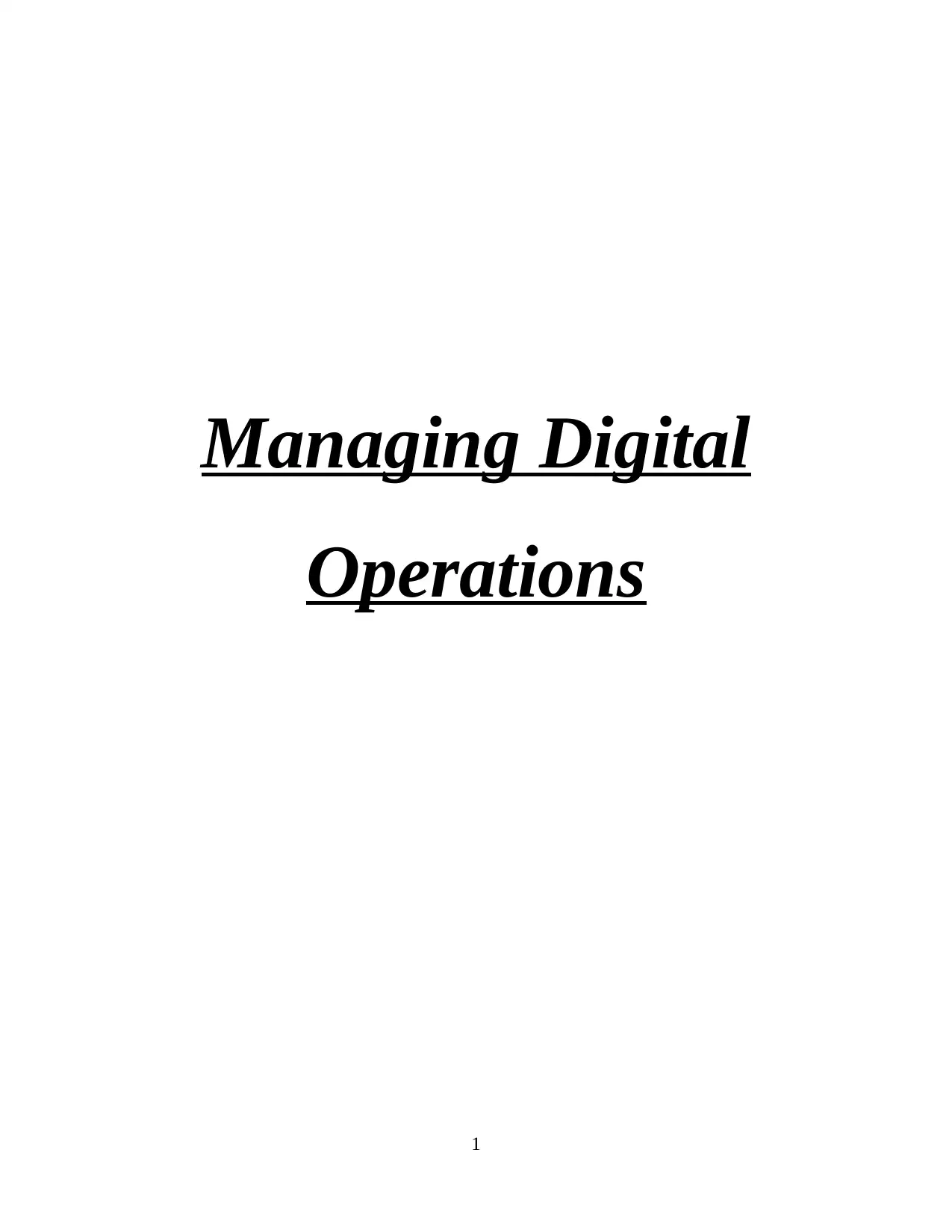
Managing Digital
Operations
1
Operations
1
Secure Best Marks with AI Grader
Need help grading? Try our AI Grader for instant feedback on your assignments.
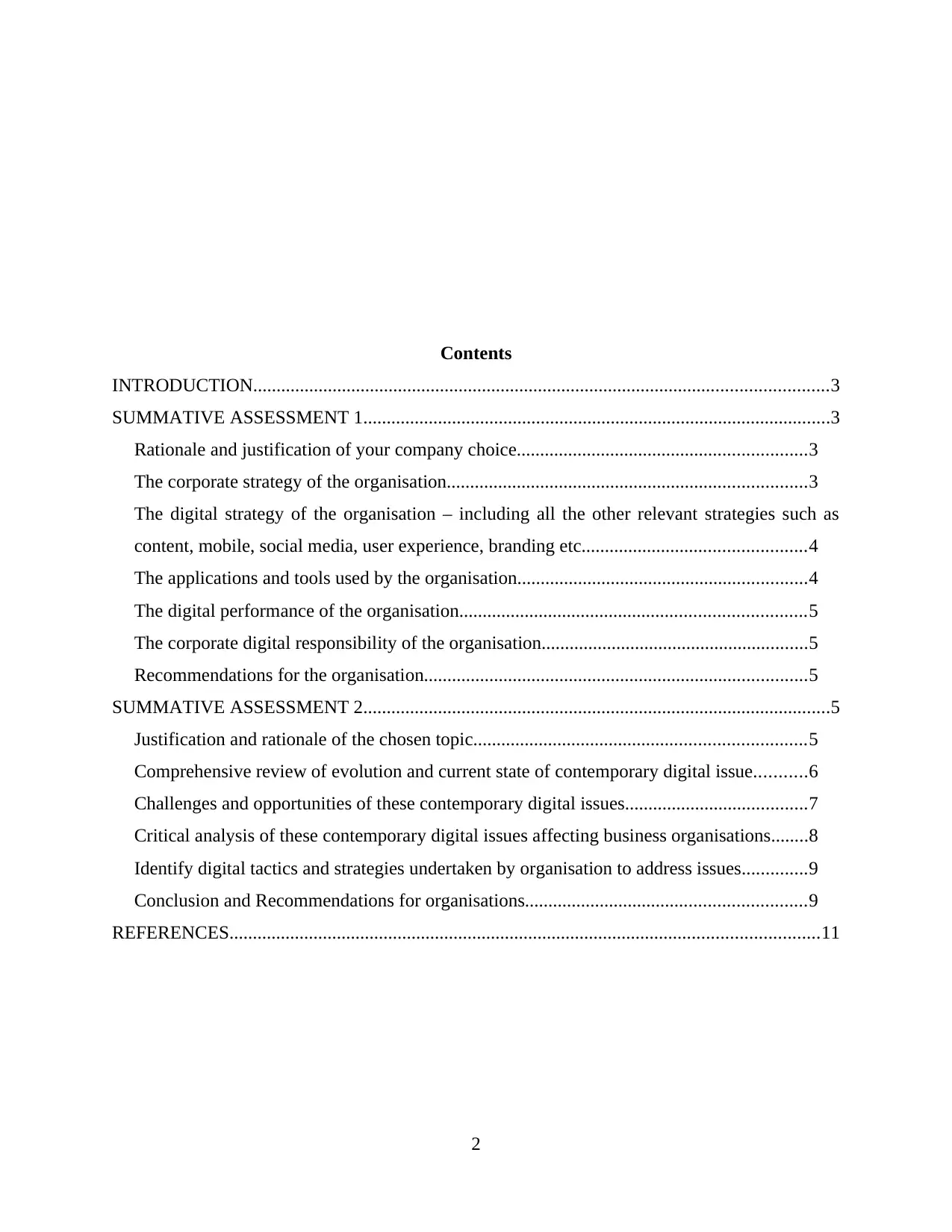
Contents
INTRODUCTION...........................................................................................................................3
SUMMATIVE ASSESSMENT 1....................................................................................................3
Rationale and justification of your company choice..............................................................3
The corporate strategy of the organisation.............................................................................3
The digital strategy of the organisation – including all the other relevant strategies such as
content, mobile, social media, user experience, branding etc................................................4
The applications and tools used by the organisation..............................................................4
The digital performance of the organisation..........................................................................5
The corporate digital responsibility of the organisation.........................................................5
Recommendations for the organisation..................................................................................5
SUMMATIVE ASSESSMENT 2....................................................................................................5
Justification and rationale of the chosen topic.......................................................................5
Comprehensive review of evolution and current state of contemporary digital issue...........6
Challenges and opportunities of these contemporary digital issues.......................................7
Critical analysis of these contemporary digital issues affecting business organisations........8
Identify digital tactics and strategies undertaken by organisation to address issues..............9
Conclusion and Recommendations for organisations............................................................9
REFERENCES..............................................................................................................................11
2
INTRODUCTION...........................................................................................................................3
SUMMATIVE ASSESSMENT 1....................................................................................................3
Rationale and justification of your company choice..............................................................3
The corporate strategy of the organisation.............................................................................3
The digital strategy of the organisation – including all the other relevant strategies such as
content, mobile, social media, user experience, branding etc................................................4
The applications and tools used by the organisation..............................................................4
The digital performance of the organisation..........................................................................5
The corporate digital responsibility of the organisation.........................................................5
Recommendations for the organisation..................................................................................5
SUMMATIVE ASSESSMENT 2....................................................................................................5
Justification and rationale of the chosen topic.......................................................................5
Comprehensive review of evolution and current state of contemporary digital issue...........6
Challenges and opportunities of these contemporary digital issues.......................................7
Critical analysis of these contemporary digital issues affecting business organisations........8
Identify digital tactics and strategies undertaken by organisation to address issues..............9
Conclusion and Recommendations for organisations............................................................9
REFERENCES..............................................................................................................................11
2

INTRODUCTION
With rapid advancement of time, various new technologies, tools and techniques are
emerging within every business sector. Enterprise have now realised the significance of adopting
digital operations in order to facilitate easier and smoothened operations within the
organisational premises. The development as well as formulation of effective digital strategies
shape the growth of business as well as ensure its sustainability in market for a long time (Čuček,
Klemeš, and Kravanja, 2012). This report is based upon Marks & Spencer which is a British
multinational retailer dealing in luxury food products, home items and clothing line. This
organisation is headquartered in London, United Kingdom.
The report is divided into two assessments. The first assessment takes into account the
corporate strategy of company as well as the digital strategy of enterprise. Also, it includes the
applications and tools used by company along with digital performance of organisation. Further
it takes into account the corporate digital responsibility and also the recommendations for this
enterprise. The second part of the report is based on critique of the same company. This
assessment highlights that this enterprise has largely been facing certain digital issues which led
to the downfall of company in global market. This report includes the evolution of digital issues
witnessed as well as the determination of opportunities and challenges associated with these
issues. Also it includes recommendations to deal with them.
SUMMATIVE ASSESSMENT 1
Rationale and justification of your company choice
The purpose of chosen study is to explore the way by which Marks and Spencer is using
Digital technology for enhancing their growth at market place. It has been evaluated that Marks
and Spencer is highly technology updated company who adopted digital technology for
improving their delivery of services towards customers in effective manner. But, as per
evaluation it has been realised that even though company is very good at using advance
technology that is digital technology in its operational activities but still requires some
improvement in the similar technology for improving their performance.
The corporate strategy of the organisation
The corporate strategy of company is to make use of the analysis and evaluation of
market and retail industry in order to devise and develop such strategies which are helpful in
3
With rapid advancement of time, various new technologies, tools and techniques are
emerging within every business sector. Enterprise have now realised the significance of adopting
digital operations in order to facilitate easier and smoothened operations within the
organisational premises. The development as well as formulation of effective digital strategies
shape the growth of business as well as ensure its sustainability in market for a long time (Čuček,
Klemeš, and Kravanja, 2012). This report is based upon Marks & Spencer which is a British
multinational retailer dealing in luxury food products, home items and clothing line. This
organisation is headquartered in London, United Kingdom.
The report is divided into two assessments. The first assessment takes into account the
corporate strategy of company as well as the digital strategy of enterprise. Also, it includes the
applications and tools used by company along with digital performance of organisation. Further
it takes into account the corporate digital responsibility and also the recommendations for this
enterprise. The second part of the report is based on critique of the same company. This
assessment highlights that this enterprise has largely been facing certain digital issues which led
to the downfall of company in global market. This report includes the evolution of digital issues
witnessed as well as the determination of opportunities and challenges associated with these
issues. Also it includes recommendations to deal with them.
SUMMATIVE ASSESSMENT 1
Rationale and justification of your company choice
The purpose of chosen study is to explore the way by which Marks and Spencer is using
Digital technology for enhancing their growth at market place. It has been evaluated that Marks
and Spencer is highly technology updated company who adopted digital technology for
improving their delivery of services towards customers in effective manner. But, as per
evaluation it has been realised that even though company is very good at using advance
technology that is digital technology in its operational activities but still requires some
improvement in the similar technology for improving their performance.
The corporate strategy of the organisation
The corporate strategy of company is to make use of the analysis and evaluation of
market and retail industry in order to devise and develop such strategies which are helpful in
3
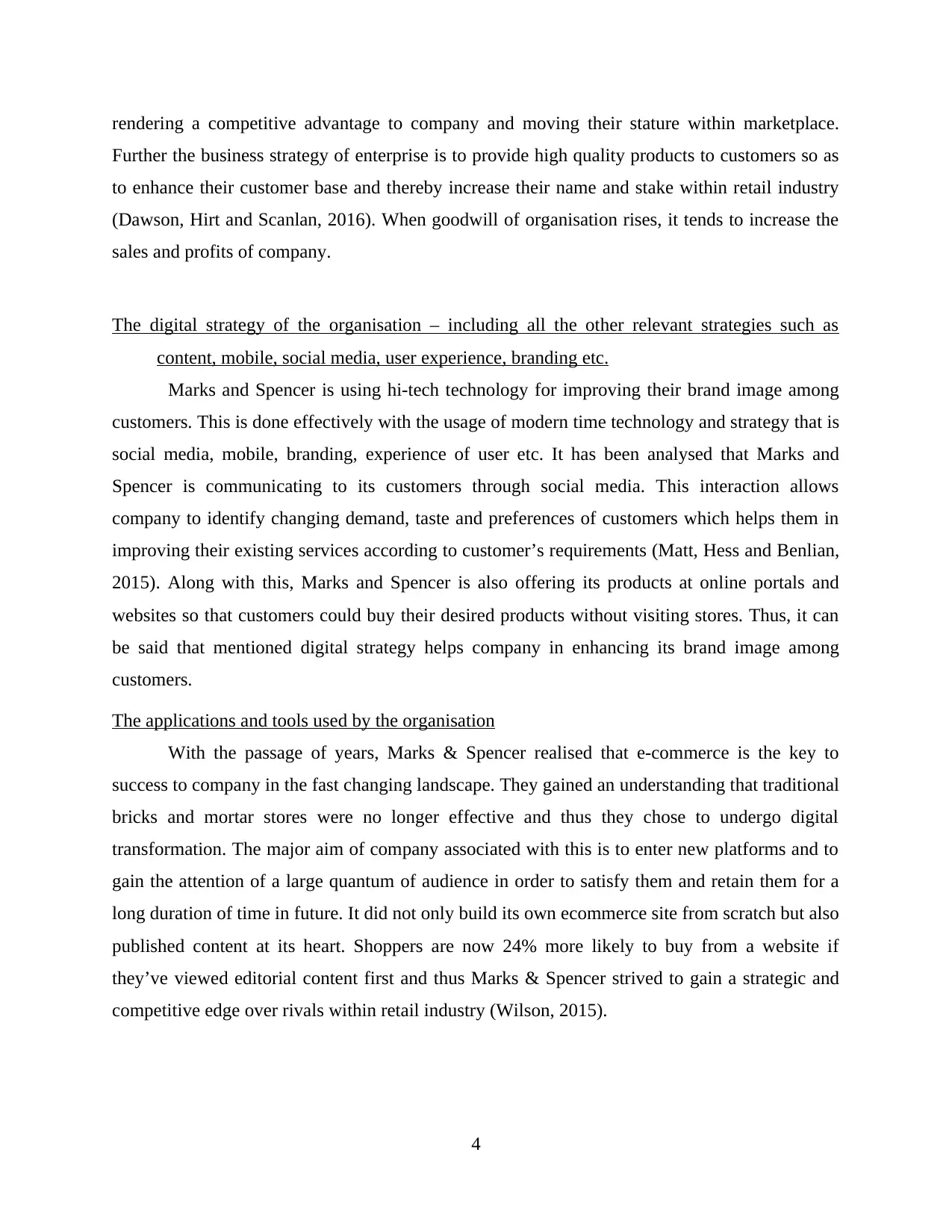
rendering a competitive advantage to company and moving their stature within marketplace.
Further the business strategy of enterprise is to provide high quality products to customers so as
to enhance their customer base and thereby increase their name and stake within retail industry
(Dawson, Hirt and Scanlan, 2016). When goodwill of organisation rises, it tends to increase the
sales and profits of company.
The digital strategy of the organisation – including all the other relevant strategies such as
content, mobile, social media, user experience, branding etc.
Marks and Spencer is using hi-tech technology for improving their brand image among
customers. This is done effectively with the usage of modern time technology and strategy that is
social media, mobile, branding, experience of user etc. It has been analysed that Marks and
Spencer is communicating to its customers through social media. This interaction allows
company to identify changing demand, taste and preferences of customers which helps them in
improving their existing services according to customer’s requirements (Matt, Hess and Benlian,
2015). Along with this, Marks and Spencer is also offering its products at online portals and
websites so that customers could buy their desired products without visiting stores. Thus, it can
be said that mentioned digital strategy helps company in enhancing its brand image among
customers.
The applications and tools used by the organisation
With the passage of years, Marks & Spencer realised that e-commerce is the key to
success to company in the fast changing landscape. They gained an understanding that traditional
bricks and mortar stores were no longer effective and thus they chose to undergo digital
transformation. The major aim of company associated with this is to enter new platforms and to
gain the attention of a large quantum of audience in order to satisfy them and retain them for a
long duration of time in future. It did not only build its own ecommerce site from scratch but also
published content at its heart. Shoppers are now 24% more likely to buy from a website if
they’ve viewed editorial content first and thus Marks & Spencer strived to gain a strategic and
competitive edge over rivals within retail industry (Wilson, 2015).
4
Further the business strategy of enterprise is to provide high quality products to customers so as
to enhance their customer base and thereby increase their name and stake within retail industry
(Dawson, Hirt and Scanlan, 2016). When goodwill of organisation rises, it tends to increase the
sales and profits of company.
The digital strategy of the organisation – including all the other relevant strategies such as
content, mobile, social media, user experience, branding etc.
Marks and Spencer is using hi-tech technology for improving their brand image among
customers. This is done effectively with the usage of modern time technology and strategy that is
social media, mobile, branding, experience of user etc. It has been analysed that Marks and
Spencer is communicating to its customers through social media. This interaction allows
company to identify changing demand, taste and preferences of customers which helps them in
improving their existing services according to customer’s requirements (Matt, Hess and Benlian,
2015). Along with this, Marks and Spencer is also offering its products at online portals and
websites so that customers could buy their desired products without visiting stores. Thus, it can
be said that mentioned digital strategy helps company in enhancing its brand image among
customers.
The applications and tools used by the organisation
With the passage of years, Marks & Spencer realised that e-commerce is the key to
success to company in the fast changing landscape. They gained an understanding that traditional
bricks and mortar stores were no longer effective and thus they chose to undergo digital
transformation. The major aim of company associated with this is to enter new platforms and to
gain the attention of a large quantum of audience in order to satisfy them and retain them for a
long duration of time in future. It did not only build its own ecommerce site from scratch but also
published content at its heart. Shoppers are now 24% more likely to buy from a website if
they’ve viewed editorial content first and thus Marks & Spencer strived to gain a strategic and
competitive edge over rivals within retail industry (Wilson, 2015).
4
Paraphrase This Document
Need a fresh take? Get an instant paraphrase of this document with our AI Paraphraser
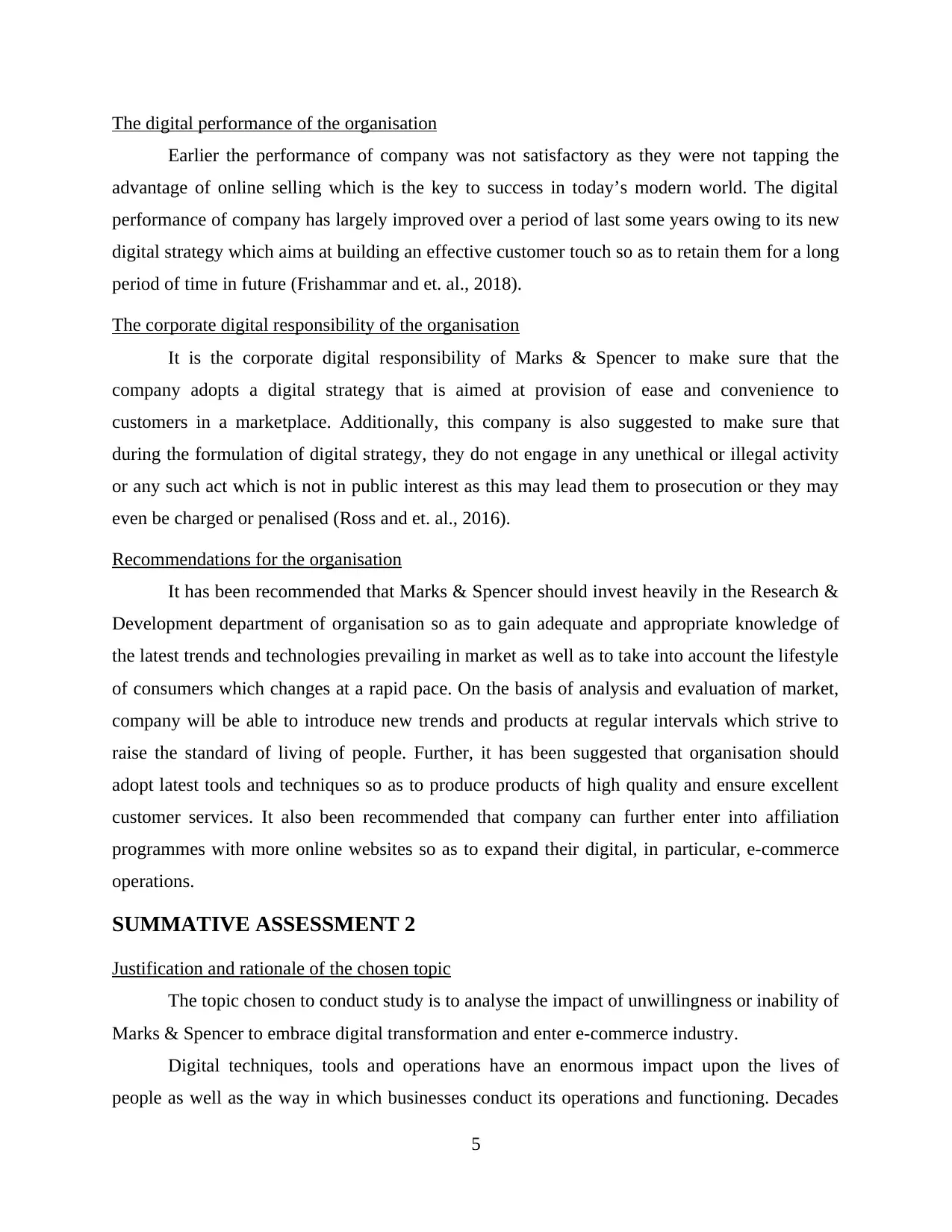
The digital performance of the organisation
Earlier the performance of company was not satisfactory as they were not tapping the
advantage of online selling which is the key to success in today’s modern world. The digital
performance of company has largely improved over a period of last some years owing to its new
digital strategy which aims at building an effective customer touch so as to retain them for a long
period of time in future (Frishammar and et. al., 2018).
The corporate digital responsibility of the organisation
It is the corporate digital responsibility of Marks & Spencer to make sure that the
company adopts a digital strategy that is aimed at provision of ease and convenience to
customers in a marketplace. Additionally, this company is also suggested to make sure that
during the formulation of digital strategy, they do not engage in any unethical or illegal activity
or any such act which is not in public interest as this may lead them to prosecution or they may
even be charged or penalised (Ross and et. al., 2016).
Recommendations for the organisation
It has been recommended that Marks & Spencer should invest heavily in the Research &
Development department of organisation so as to gain adequate and appropriate knowledge of
the latest trends and technologies prevailing in market as well as to take into account the lifestyle
of consumers which changes at a rapid pace. On the basis of analysis and evaluation of market,
company will be able to introduce new trends and products at regular intervals which strive to
raise the standard of living of people. Further, it has been suggested that organisation should
adopt latest tools and techniques so as to produce products of high quality and ensure excellent
customer services. It also been recommended that company can further enter into affiliation
programmes with more online websites so as to expand their digital, in particular, e-commerce
operations.
SUMMATIVE ASSESSMENT 2
Justification and rationale of the chosen topic
The topic chosen to conduct study is to analyse the impact of unwillingness or inability of
Marks & Spencer to embrace digital transformation and enter e-commerce industry.
Digital techniques, tools and operations have an enormous impact upon the lives of
people as well as the way in which businesses conduct its operations and functioning. Decades
5
Earlier the performance of company was not satisfactory as they were not tapping the
advantage of online selling which is the key to success in today’s modern world. The digital
performance of company has largely improved over a period of last some years owing to its new
digital strategy which aims at building an effective customer touch so as to retain them for a long
period of time in future (Frishammar and et. al., 2018).
The corporate digital responsibility of the organisation
It is the corporate digital responsibility of Marks & Spencer to make sure that the
company adopts a digital strategy that is aimed at provision of ease and convenience to
customers in a marketplace. Additionally, this company is also suggested to make sure that
during the formulation of digital strategy, they do not engage in any unethical or illegal activity
or any such act which is not in public interest as this may lead them to prosecution or they may
even be charged or penalised (Ross and et. al., 2016).
Recommendations for the organisation
It has been recommended that Marks & Spencer should invest heavily in the Research &
Development department of organisation so as to gain adequate and appropriate knowledge of
the latest trends and technologies prevailing in market as well as to take into account the lifestyle
of consumers which changes at a rapid pace. On the basis of analysis and evaluation of market,
company will be able to introduce new trends and products at regular intervals which strive to
raise the standard of living of people. Further, it has been suggested that organisation should
adopt latest tools and techniques so as to produce products of high quality and ensure excellent
customer services. It also been recommended that company can further enter into affiliation
programmes with more online websites so as to expand their digital, in particular, e-commerce
operations.
SUMMATIVE ASSESSMENT 2
Justification and rationale of the chosen topic
The topic chosen to conduct study is to analyse the impact of unwillingness or inability of
Marks & Spencer to embrace digital transformation and enter e-commerce industry.
Digital techniques, tools and operations have an enormous impact upon the lives of
people as well as the way in which businesses conduct its operations and functioning. Decades
5
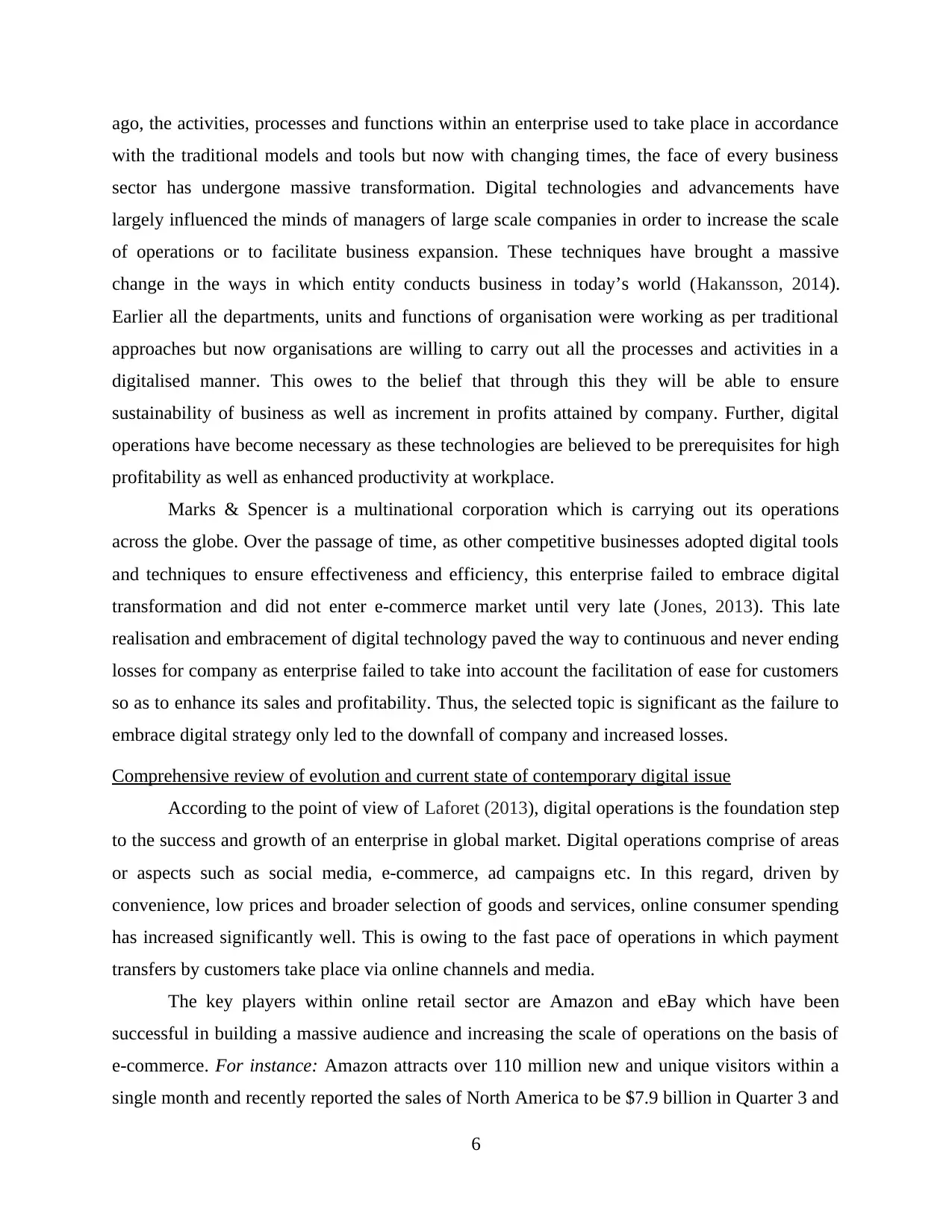
ago, the activities, processes and functions within an enterprise used to take place in accordance
with the traditional models and tools but now with changing times, the face of every business
sector has undergone massive transformation. Digital technologies and advancements have
largely influenced the minds of managers of large scale companies in order to increase the scale
of operations or to facilitate business expansion. These techniques have brought a massive
change in the ways in which entity conducts business in today’s world (Hakansson, 2014).
Earlier all the departments, units and functions of organisation were working as per traditional
approaches but now organisations are willing to carry out all the processes and activities in a
digitalised manner. This owes to the belief that through this they will be able to ensure
sustainability of business as well as increment in profits attained by company. Further, digital
operations have become necessary as these technologies are believed to be prerequisites for high
profitability as well as enhanced productivity at workplace.
Marks & Spencer is a multinational corporation which is carrying out its operations
across the globe. Over the passage of time, as other competitive businesses adopted digital tools
and techniques to ensure effectiveness and efficiency, this enterprise failed to embrace digital
transformation and did not enter e-commerce market until very late (Jones, 2013). This late
realisation and embracement of digital technology paved the way to continuous and never ending
losses for company as enterprise failed to take into account the facilitation of ease for customers
so as to enhance its sales and profitability. Thus, the selected topic is significant as the failure to
embrace digital strategy only led to the downfall of company and increased losses.
Comprehensive review of evolution and current state of contemporary digital issue
According to the point of view of Laforet (2013), digital operations is the foundation step
to the success and growth of an enterprise in global market. Digital operations comprise of areas
or aspects such as social media, e-commerce, ad campaigns etc. In this regard, driven by
convenience, low prices and broader selection of goods and services, online consumer spending
has increased significantly well. This is owing to the fast pace of operations in which payment
transfers by customers take place via online channels and media.
The key players within online retail sector are Amazon and eBay which have been
successful in building a massive audience and increasing the scale of operations on the basis of
e-commerce. For instance: Amazon attracts over 110 million new and unique visitors within a
single month and recently reported the sales of North America to be $7.9 billion in Quarter 3 and
6
with the traditional models and tools but now with changing times, the face of every business
sector has undergone massive transformation. Digital technologies and advancements have
largely influenced the minds of managers of large scale companies in order to increase the scale
of operations or to facilitate business expansion. These techniques have brought a massive
change in the ways in which entity conducts business in today’s world (Hakansson, 2014).
Earlier all the departments, units and functions of organisation were working as per traditional
approaches but now organisations are willing to carry out all the processes and activities in a
digitalised manner. This owes to the belief that through this they will be able to ensure
sustainability of business as well as increment in profits attained by company. Further, digital
operations have become necessary as these technologies are believed to be prerequisites for high
profitability as well as enhanced productivity at workplace.
Marks & Spencer is a multinational corporation which is carrying out its operations
across the globe. Over the passage of time, as other competitive businesses adopted digital tools
and techniques to ensure effectiveness and efficiency, this enterprise failed to embrace digital
transformation and did not enter e-commerce market until very late (Jones, 2013). This late
realisation and embracement of digital technology paved the way to continuous and never ending
losses for company as enterprise failed to take into account the facilitation of ease for customers
so as to enhance its sales and profitability. Thus, the selected topic is significant as the failure to
embrace digital strategy only led to the downfall of company and increased losses.
Comprehensive review of evolution and current state of contemporary digital issue
According to the point of view of Laforet (2013), digital operations is the foundation step
to the success and growth of an enterprise in global market. Digital operations comprise of areas
or aspects such as social media, e-commerce, ad campaigns etc. In this regard, driven by
convenience, low prices and broader selection of goods and services, online consumer spending
has increased significantly well. This is owing to the fast pace of operations in which payment
transfers by customers take place via online channels and media.
The key players within online retail sector are Amazon and eBay which have been
successful in building a massive audience and increasing the scale of operations on the basis of
e-commerce. For instance: Amazon attracts over 110 million new and unique visitors within a
single month and recently reported the sales of North America to be $7.9 billion in Quarter 3 and
6
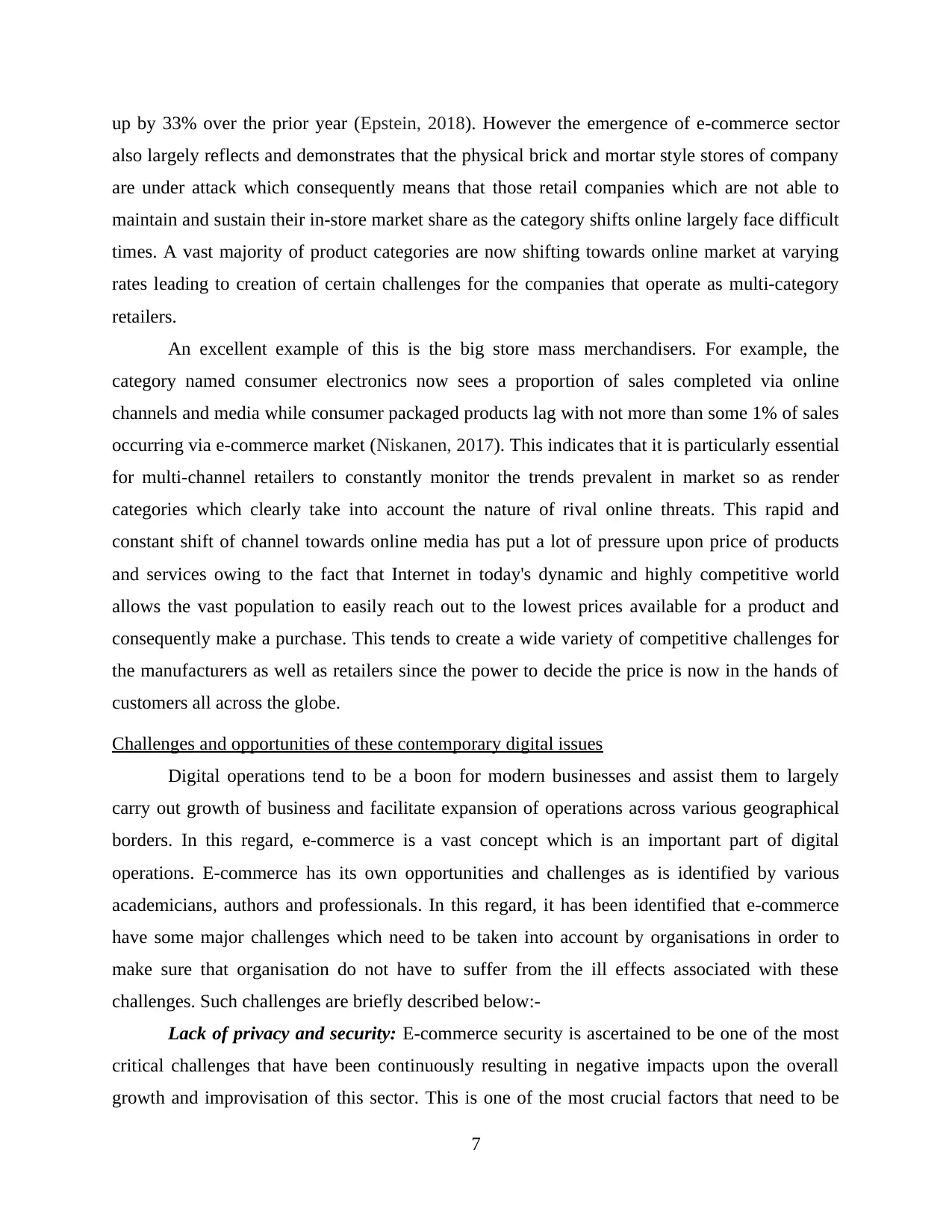
up by 33% over the prior year (Epstein, 2018). However the emergence of e-commerce sector
also largely reflects and demonstrates that the physical brick and mortar style stores of company
are under attack which consequently means that those retail companies which are not able to
maintain and sustain their in-store market share as the category shifts online largely face difficult
times. A vast majority of product categories are now shifting towards online market at varying
rates leading to creation of certain challenges for the companies that operate as multi-category
retailers.
An excellent example of this is the big store mass merchandisers. For example, the
category named consumer electronics now sees a proportion of sales completed via online
channels and media while consumer packaged products lag with not more than some 1% of sales
occurring via e-commerce market (Niskanen, 2017). This indicates that it is particularly essential
for multi-channel retailers to constantly monitor the trends prevalent in market so as render
categories which clearly take into account the nature of rival online threats. This rapid and
constant shift of channel towards online media has put a lot of pressure upon price of products
and services owing to the fact that Internet in today's dynamic and highly competitive world
allows the vast population to easily reach out to the lowest prices available for a product and
consequently make a purchase. This tends to create a wide variety of competitive challenges for
the manufacturers as well as retailers since the power to decide the price is now in the hands of
customers all across the globe.
Challenges and opportunities of these contemporary digital issues
Digital operations tend to be a boon for modern businesses and assist them to largely
carry out growth of business and facilitate expansion of operations across various geographical
borders. In this regard, e-commerce is a vast concept which is an important part of digital
operations. E-commerce has its own opportunities and challenges as is identified by various
academicians, authors and professionals. In this regard, it has been identified that e-commerce
have some major challenges which need to be taken into account by organisations in order to
make sure that organisation do not have to suffer from the ill effects associated with these
challenges. Such challenges are briefly described below:-
Lack of privacy and security: E-commerce security is ascertained to be one of the most
critical challenges that have been continuously resulting in negative impacts upon the overall
growth and improvisation of this sector. This is one of the most crucial factors that need to be
7
also largely reflects and demonstrates that the physical brick and mortar style stores of company
are under attack which consequently means that those retail companies which are not able to
maintain and sustain their in-store market share as the category shifts online largely face difficult
times. A vast majority of product categories are now shifting towards online market at varying
rates leading to creation of certain challenges for the companies that operate as multi-category
retailers.
An excellent example of this is the big store mass merchandisers. For example, the
category named consumer electronics now sees a proportion of sales completed via online
channels and media while consumer packaged products lag with not more than some 1% of sales
occurring via e-commerce market (Niskanen, 2017). This indicates that it is particularly essential
for multi-channel retailers to constantly monitor the trends prevalent in market so as render
categories which clearly take into account the nature of rival online threats. This rapid and
constant shift of channel towards online media has put a lot of pressure upon price of products
and services owing to the fact that Internet in today's dynamic and highly competitive world
allows the vast population to easily reach out to the lowest prices available for a product and
consequently make a purchase. This tends to create a wide variety of competitive challenges for
the manufacturers as well as retailers since the power to decide the price is now in the hands of
customers all across the globe.
Challenges and opportunities of these contemporary digital issues
Digital operations tend to be a boon for modern businesses and assist them to largely
carry out growth of business and facilitate expansion of operations across various geographical
borders. In this regard, e-commerce is a vast concept which is an important part of digital
operations. E-commerce has its own opportunities and challenges as is identified by various
academicians, authors and professionals. In this regard, it has been identified that e-commerce
have some major challenges which need to be taken into account by organisations in order to
make sure that organisation do not have to suffer from the ill effects associated with these
challenges. Such challenges are briefly described below:-
Lack of privacy and security: E-commerce security is ascertained to be one of the most
critical challenges that have been continuously resulting in negative impacts upon the overall
growth and improvisation of this sector. This is one of the most crucial factors that need to be
7
Secure Best Marks with AI Grader
Need help grading? Try our AI Grader for instant feedback on your assignments.
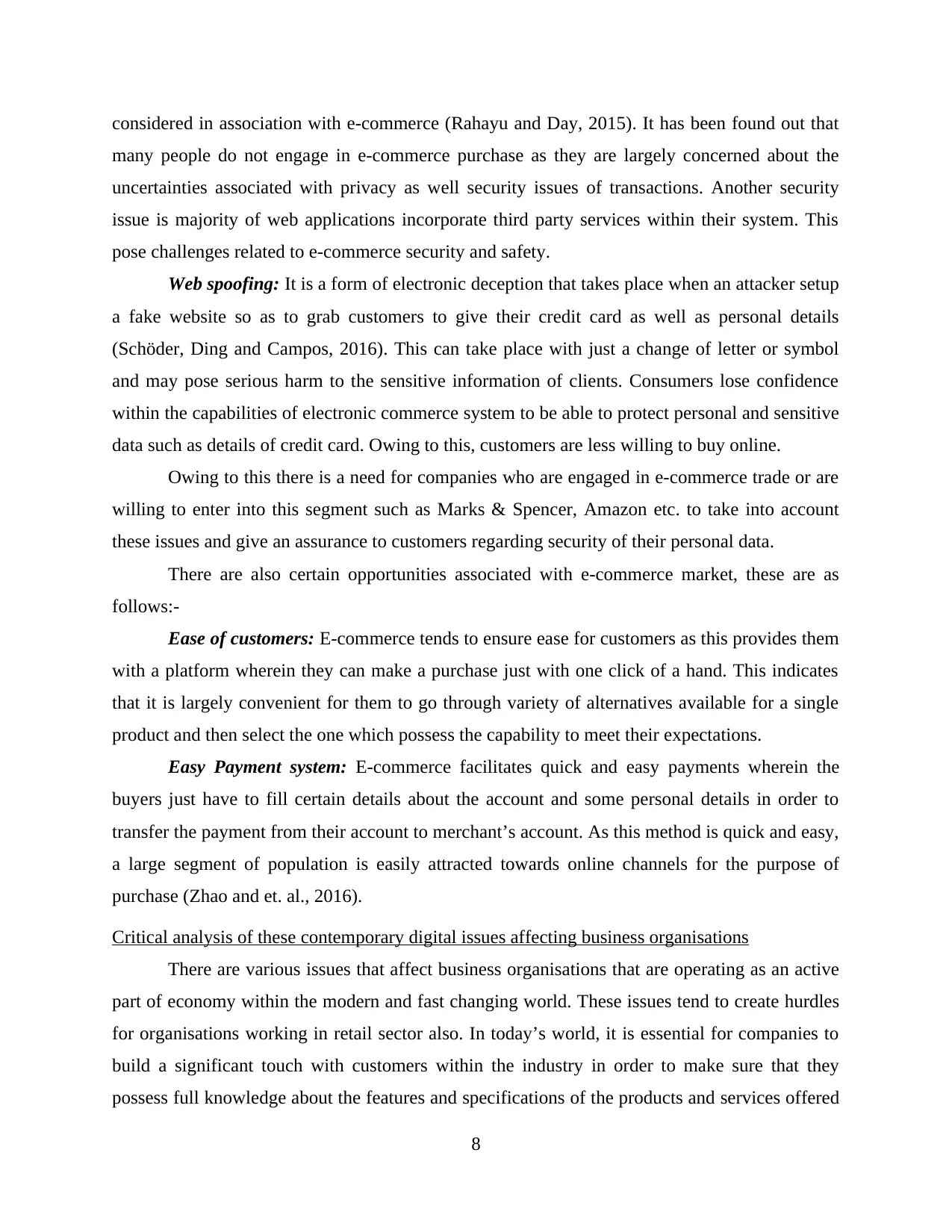
considered in association with e-commerce (Rahayu and Day, 2015). It has been found out that
many people do not engage in e-commerce purchase as they are largely concerned about the
uncertainties associated with privacy as well security issues of transactions. Another security
issue is majority of web applications incorporate third party services within their system. This
pose challenges related to e-commerce security and safety.
Web spoofing: It is a form of electronic deception that takes place when an attacker setup
a fake website so as to grab customers to give their credit card as well as personal details
(Schöder, Ding and Campos, 2016). This can take place with just a change of letter or symbol
and may pose serious harm to the sensitive information of clients. Consumers lose confidence
within the capabilities of electronic commerce system to be able to protect personal and sensitive
data such as details of credit card. Owing to this, customers are less willing to buy online.
Owing to this there is a need for companies who are engaged in e-commerce trade or are
willing to enter into this segment such as Marks & Spencer, Amazon etc. to take into account
these issues and give an assurance to customers regarding security of their personal data.
There are also certain opportunities associated with e-commerce market, these are as
follows:-
Ease of customers: E-commerce tends to ensure ease for customers as this provides them
with a platform wherein they can make a purchase just with one click of a hand. This indicates
that it is largely convenient for them to go through variety of alternatives available for a single
product and then select the one which possess the capability to meet their expectations.
Easy Payment system: E-commerce facilitates quick and easy payments wherein the
buyers just have to fill certain details about the account and some personal details in order to
transfer the payment from their account to merchant’s account. As this method is quick and easy,
a large segment of population is easily attracted towards online channels for the purpose of
purchase (Zhao and et. al., 2016).
Critical analysis of these contemporary digital issues affecting business organisations
There are various issues that affect business organisations that are operating as an active
part of economy within the modern and fast changing world. These issues tend to create hurdles
for organisations working in retail sector also. In today’s world, it is essential for companies to
build a significant touch with customers within the industry in order to make sure that they
possess full knowledge about the features and specifications of the products and services offered
8
many people do not engage in e-commerce purchase as they are largely concerned about the
uncertainties associated with privacy as well security issues of transactions. Another security
issue is majority of web applications incorporate third party services within their system. This
pose challenges related to e-commerce security and safety.
Web spoofing: It is a form of electronic deception that takes place when an attacker setup
a fake website so as to grab customers to give their credit card as well as personal details
(Schöder, Ding and Campos, 2016). This can take place with just a change of letter or symbol
and may pose serious harm to the sensitive information of clients. Consumers lose confidence
within the capabilities of electronic commerce system to be able to protect personal and sensitive
data such as details of credit card. Owing to this, customers are less willing to buy online.
Owing to this there is a need for companies who are engaged in e-commerce trade or are
willing to enter into this segment such as Marks & Spencer, Amazon etc. to take into account
these issues and give an assurance to customers regarding security of their personal data.
There are also certain opportunities associated with e-commerce market, these are as
follows:-
Ease of customers: E-commerce tends to ensure ease for customers as this provides them
with a platform wherein they can make a purchase just with one click of a hand. This indicates
that it is largely convenient for them to go through variety of alternatives available for a single
product and then select the one which possess the capability to meet their expectations.
Easy Payment system: E-commerce facilitates quick and easy payments wherein the
buyers just have to fill certain details about the account and some personal details in order to
transfer the payment from their account to merchant’s account. As this method is quick and easy,
a large segment of population is easily attracted towards online channels for the purpose of
purchase (Zhao and et. al., 2016).
Critical analysis of these contemporary digital issues affecting business organisations
There are various issues that affect business organisations that are operating as an active
part of economy within the modern and fast changing world. These issues tend to create hurdles
for organisations working in retail sector also. In today’s world, it is essential for companies to
build a significant touch with customers within the industry in order to make sure that they
possess full knowledge about the features and specifications of the products and services offered
8

by companies such as Marks & Spencer. Further it is necessary that organisation operates in a
manner which ensures ease and pace of operations and maximum satisfaction to customers
(Laudon and Traver, 2016). In this regard, e-commerce is a vast market which have various key
players yet only those players are able to sustain in market which possess the capabilities to take
into account the challenges that digital issues pose to the company and develop organisational
strategies and tactics accordingly.
Identify digital tactics and strategies undertaken by organisation to address issues
In order to successfully and feasibly deal with digital issues, organisations adopt digital
strategies and tactics. For instance: Marks & Spencer was an enterprise that was very late within
retail industry to realise the significance of entering into online marketing and tap the advantage
of enhancing the customer base by offering its products at various online websites. Yet when the
organisation dawned upon the fact that company was suffering immensely because of the lack of
initiative, they adopted a digital strategy wherein they started offering their products online so as
to compete with the rivals in an effective manner. With this company was able to survive within
online market in order to enhance the existing base of customers.
Conclusion and Recommendations for organisations
As per the above discussion in the report, it has been concluded that formulation of a new
and unique technology is often beneficial for any enterprise as it tends to improve its existing
level of productivity and the profitability of organisation as well. Also, it has been evaluated that
use of latest and advanced technologies has certain considerations that need to be taken into
account by the managers of the enterprise to ensure that there is no negative impact associated
with its implementation across the organisational premises. It has been analysed that digital
technology such as social media, creative advertising etc. assist an enterprise in gaining the
attention of a large number of people yet organisations fail to realise that it has certain drawbacks
too which should be considered.
Digital technologies leads to smoother functioning as this is intended towards building a
healthy and effective relationship with clients so as to captivate their attention and retain them
for a long time period in future context. Adoption of advanced technologies requires huge
investment of time, efforts and money to make sure that the implementation takes place
successfully within the organisation. Further, it has been observed that the need for adoption of
9
manner which ensures ease and pace of operations and maximum satisfaction to customers
(Laudon and Traver, 2016). In this regard, e-commerce is a vast market which have various key
players yet only those players are able to sustain in market which possess the capabilities to take
into account the challenges that digital issues pose to the company and develop organisational
strategies and tactics accordingly.
Identify digital tactics and strategies undertaken by organisation to address issues
In order to successfully and feasibly deal with digital issues, organisations adopt digital
strategies and tactics. For instance: Marks & Spencer was an enterprise that was very late within
retail industry to realise the significance of entering into online marketing and tap the advantage
of enhancing the customer base by offering its products at various online websites. Yet when the
organisation dawned upon the fact that company was suffering immensely because of the lack of
initiative, they adopted a digital strategy wherein they started offering their products online so as
to compete with the rivals in an effective manner. With this company was able to survive within
online market in order to enhance the existing base of customers.
Conclusion and Recommendations for organisations
As per the above discussion in the report, it has been concluded that formulation of a new
and unique technology is often beneficial for any enterprise as it tends to improve its existing
level of productivity and the profitability of organisation as well. Also, it has been evaluated that
use of latest and advanced technologies has certain considerations that need to be taken into
account by the managers of the enterprise to ensure that there is no negative impact associated
with its implementation across the organisational premises. It has been analysed that digital
technology such as social media, creative advertising etc. assist an enterprise in gaining the
attention of a large number of people yet organisations fail to realise that it has certain drawbacks
too which should be considered.
Digital technologies leads to smoother functioning as this is intended towards building a
healthy and effective relationship with clients so as to captivate their attention and retain them
for a long time period in future context. Adoption of advanced technologies requires huge
investment of time, efforts and money to make sure that the implementation takes place
successfully within the organisation. Further, it has been observed that the need for adoption of
9
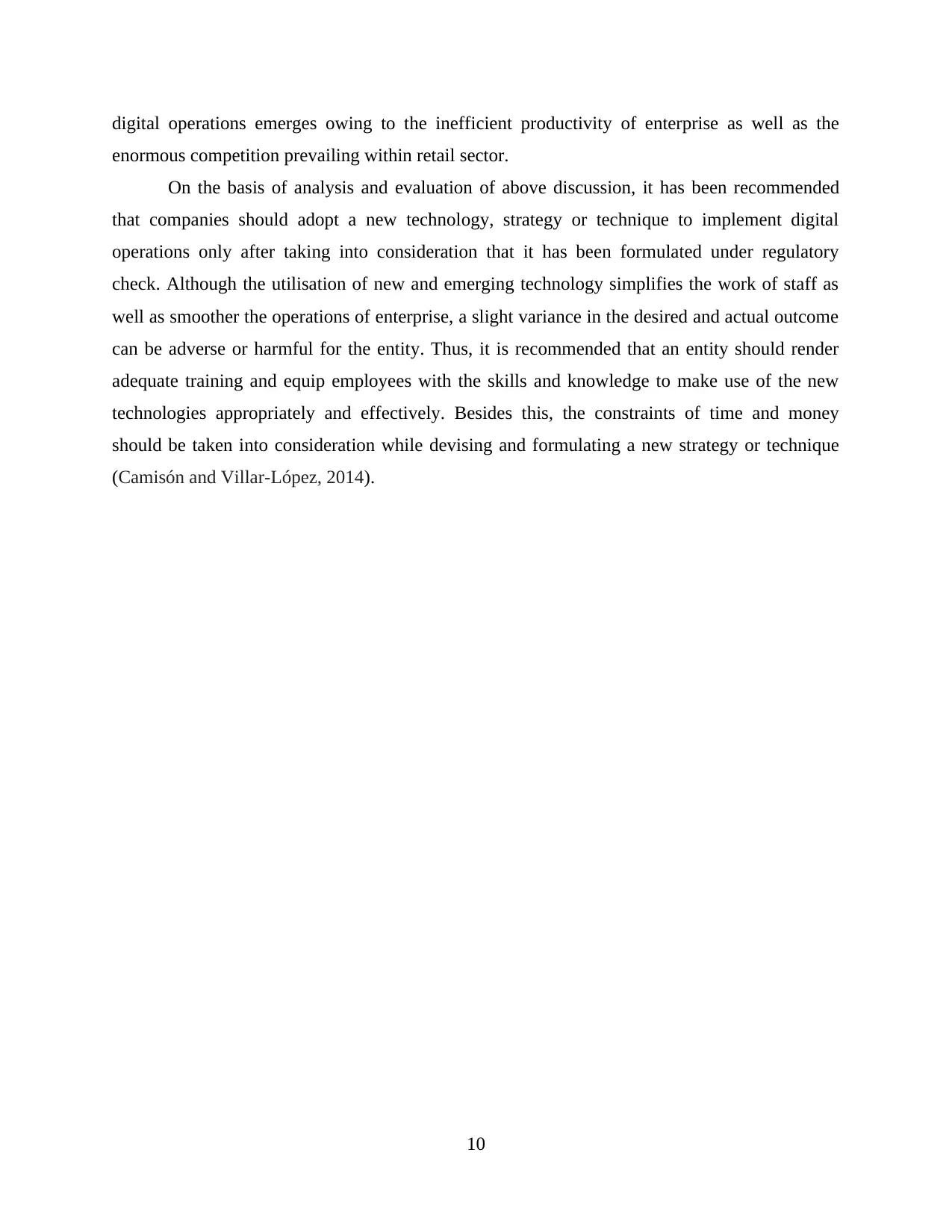
digital operations emerges owing to the inefficient productivity of enterprise as well as the
enormous competition prevailing within retail sector.
On the basis of analysis and evaluation of above discussion, it has been recommended
that companies should adopt a new technology, strategy or technique to implement digital
operations only after taking into consideration that it has been formulated under regulatory
check. Although the utilisation of new and emerging technology simplifies the work of staff as
well as smoother the operations of enterprise, a slight variance in the desired and actual outcome
can be adverse or harmful for the entity. Thus, it is recommended that an entity should render
adequate training and equip employees with the skills and knowledge to make use of the new
technologies appropriately and effectively. Besides this, the constraints of time and money
should be taken into consideration while devising and formulating a new strategy or technique
(Camisón and Villar-López, 2014).
10
enormous competition prevailing within retail sector.
On the basis of analysis and evaluation of above discussion, it has been recommended
that companies should adopt a new technology, strategy or technique to implement digital
operations only after taking into consideration that it has been formulated under regulatory
check. Although the utilisation of new and emerging technology simplifies the work of staff as
well as smoother the operations of enterprise, a slight variance in the desired and actual outcome
can be adverse or harmful for the entity. Thus, it is recommended that an entity should render
adequate training and equip employees with the skills and knowledge to make use of the new
technologies appropriately and effectively. Besides this, the constraints of time and money
should be taken into consideration while devising and formulating a new strategy or technique
(Camisón and Villar-López, 2014).
10
Paraphrase This Document
Need a fresh take? Get an instant paraphrase of this document with our AI Paraphraser

REFERENCES
Books and Journals
Camisón, C. and Villar-López, A., 2014. Organizational innovation as an enabler of
technological innovation capabilities and firm performance. Journal of business research.
67(1). pp.2891-2902.
Čuček, L., Klemeš, J. J. and Kravanja, Z., 2012. A review of footprint analysis tools for
monitoring impacts on sustainability. Journal of Cleaner Production. 34. pp.9-20.
Dawson, A., Hirt, M. and Scanlan, J., 2016. The economic essentials of digital
strategy. McKinsey Quarterly. 3. p.45.
Epstein, M. J., 2018. Making sustainability work: Best practices in managing and measuring
corporate social, environmental and economic impacts. Routledge.
Frishammar, J. and et. al., 2018. Digital strategies for two-sided markets: A case study of
shopping malls. Decision Support Systems. 108. pp.34-44.
Hakansson, H., 2014. Corporate Technological Behaviour (Routledge Revivals): Co-opertation
and Networks. Routledge.
Jones, G. R., 2013. Organizational theory, design, and change. Upper Saddle River, NJ:
Pearson,.
Kim, Y. and Peterson, R.A., 2017. A Meta-analysis of Online Trust Relationships in E-
commerce. Journal of Interactive Marketing. 38. pp.44-54.
Laforet, S., 2013. Organizational innovation outcomes in SMEs: Effects of age, size, and
sector. Journal of World business. 48(4). pp.490-502.
Laudon, K. C. and Traver, C. G., 2016. E-commerce: business, technology, society.
Matt, C., Hess, T. and Benlian, A., 2015. Digital transformation strategies. Business &
Information Systems Engineering. 57(5). pp.339-343.
Niskanen, J., 2017. Bureaucracy and representative government. Routledge.
Rahayu, R. and Day, J., 2015. Determinant factors of e-commerce adoption by SMEs in
developing country: evidence from Indonesia. Procedia-Social and Behavioral
Sciences. 195. pp.142-150.
Ross, J. W. and et. al., 2016. Designing and executing digital strategies.
Schöder, D., Ding, F. and Campos, J. K., 2016. The impact of e-commerce development on
urban logistics sustainability. Open Journal of Social Sciences. 4(03). p.1.
Wilson, J. P., 2015. The triple bottom line: Undertaking an economic, social, and environmental
retail sustainability strategy. International Journal of Retail & Distribution
Management. 43(4/5). pp.432-447.
Zhao, W. X. and et. al., 2016. Connecting social media to e-commerce: Cold-start product
recommendation using microblogging information. IEEE Transactions on Knowledge
and Data Engineering. 28(5). pp.1147-1159.
11
Books and Journals
Camisón, C. and Villar-López, A., 2014. Organizational innovation as an enabler of
technological innovation capabilities and firm performance. Journal of business research.
67(1). pp.2891-2902.
Čuček, L., Klemeš, J. J. and Kravanja, Z., 2012. A review of footprint analysis tools for
monitoring impacts on sustainability. Journal of Cleaner Production. 34. pp.9-20.
Dawson, A., Hirt, M. and Scanlan, J., 2016. The economic essentials of digital
strategy. McKinsey Quarterly. 3. p.45.
Epstein, M. J., 2018. Making sustainability work: Best practices in managing and measuring
corporate social, environmental and economic impacts. Routledge.
Frishammar, J. and et. al., 2018. Digital strategies for two-sided markets: A case study of
shopping malls. Decision Support Systems. 108. pp.34-44.
Hakansson, H., 2014. Corporate Technological Behaviour (Routledge Revivals): Co-opertation
and Networks. Routledge.
Jones, G. R., 2013. Organizational theory, design, and change. Upper Saddle River, NJ:
Pearson,.
Kim, Y. and Peterson, R.A., 2017. A Meta-analysis of Online Trust Relationships in E-
commerce. Journal of Interactive Marketing. 38. pp.44-54.
Laforet, S., 2013. Organizational innovation outcomes in SMEs: Effects of age, size, and
sector. Journal of World business. 48(4). pp.490-502.
Laudon, K. C. and Traver, C. G., 2016. E-commerce: business, technology, society.
Matt, C., Hess, T. and Benlian, A., 2015. Digital transformation strategies. Business &
Information Systems Engineering. 57(5). pp.339-343.
Niskanen, J., 2017. Bureaucracy and representative government. Routledge.
Rahayu, R. and Day, J., 2015. Determinant factors of e-commerce adoption by SMEs in
developing country: evidence from Indonesia. Procedia-Social and Behavioral
Sciences. 195. pp.142-150.
Ross, J. W. and et. al., 2016. Designing and executing digital strategies.
Schöder, D., Ding, F. and Campos, J. K., 2016. The impact of e-commerce development on
urban logistics sustainability. Open Journal of Social Sciences. 4(03). p.1.
Wilson, J. P., 2015. The triple bottom line: Undertaking an economic, social, and environmental
retail sustainability strategy. International Journal of Retail & Distribution
Management. 43(4/5). pp.432-447.
Zhao, W. X. and et. al., 2016. Connecting social media to e-commerce: Cold-start product
recommendation using microblogging information. IEEE Transactions on Knowledge
and Data Engineering. 28(5). pp.1147-1159.
11
1 out of 11
![[object Object]](/_next/static/media/star-bottom.7253800d.svg)




